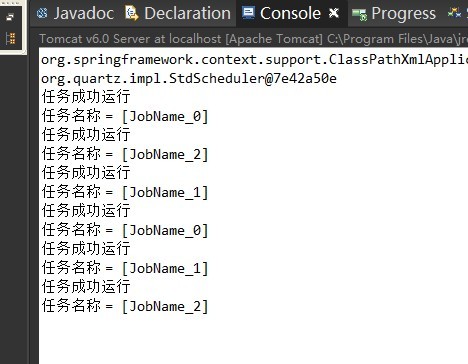项目ITP(六) spring4.0 整合 Quartz 实现动态任务调度
前言
系列文章:[传送门]
项目需求:
http://www.cnblogs.com/Alandre/p/3733249.html
上一博客写的是基本调度,后来这只能用于,像每天定个时间 进行数据库备份。但是,远远不能在上次的需求上实现。所以需要实现spring4.0 整合 Quartz 实现动态任务调度。
正文
spring4.0 整合 Quartz 实现任务调度。这真是期末项目的最后一篇,剩下到暑假吧。
Quartz 介绍
Quartz is a full-featured, open source job scheduling service that can be integrated with, or used along side virtually any Java application - from the smallest stand-alone application to the largest e-commerce system. Quartz can be used to create simple or complex schedules for executing tens, hundreds, or even tens-of-thousands of jobs;
Quartz框架是一个全功能、开源的任务调度服务,可以集成几乎任何的java应用程序—从小的单片机系统到大型的电子商务系统。Quartz可以执行上千上万的任务调度。
核心概念
Quartz核心的概念:scheduler任务调度、Job任务、Trigger触发器、JobDetail任务细节
回顾
上次我们配置了
<!--Quartz--> <!-- 集成方式:JobDetailFactoryBean,并且任务类需要继承QuartzJobBean--> <!-- 定义jobDetail --> <bean id="jobDetail" class="org.springframework.scheduling.quartz.JobDetailFactoryBean"> <!-- durability 表示任务完成之后是否依然保留到数据库,默认false --> <property name="durability" value="true" /> <!-- 目标类 /wmuitp/src/test/SpringQuartz.java--> <property name="jobClass" value="test.SpringQuartzTest"></property> <!-- 在这个例子中,jobDataAsMap没有用,此目标类中接受的参数 ,若参数为service,则可以在此进行参数配置,类似struts2 --> <!-- <property name="jobDataAsMap"> <map> <entry key="service"><value>simple is the beat</value></entry> </map> </property> --> </bean> <!-- 定义simpleTrigger触发器 --> <!-- <bean id="simpleTrigger" class="org.springframework.scheduling.quartz.SimpleTriggerBean"> <property name="jobDetail" ref="jobDetail"></property> <property name="repeatCount"> <value>8</value> </property> <property name="repeatInterval"> <value>1000</value> </property> <property name="startDelay"> <value>4</value> </property> </bean> --> <!-- 另一种触发器是CornTrigger --> <bean id="cornTrigger" class="org.springframework.scheduling.quartz.CronTriggerFactoryBean"> <property name="jobDetail" ref="jobDetail"/> <!-- 每个10秒触发 --> <property name="cronExpression" value="0/10 * * * * ?"/> </bean> <!-- 定义核心调度器 --> <bean id="scheduler" class="org.springframework.scheduling.quartz.SchedulerFactoryBean"> <property name="triggers"> <ref bean="cornTrigger"/> </property> </bean>
#spring实现quartz的方式,先看一下上面配置文件中定义的jobDetail。在Quartz 2.x版本中JobDetail已经是一个接口,Spring是通过将其转换为MethodInvokingJob或StatefulMethodInvokingJob类型来实现的。
这是文档中的源码:
/** * This implementation applies the passed-in job data map as bean property * values, and delegates to <code>executeInternal</code> afterwards. * @see #executeInternal */ public final void execute(JobExecutionContext context) throws JobExecutionException { try { // Reflectively adapting to differences between Quartz 1.x and Quartz 2.0... Scheduler scheduler = (Scheduler) ReflectionUtils.invokeMethod(getSchedulerMethod, context); Map mergedJobDataMap = (Map) ReflectionUtils.invokeMethod(getMergedJobDataMapMethod, context); BeanWrapper bw = PropertyAccessorFactory.forBeanPropertyAccess(this); MutablePropertyValues pvs = new MutablePropertyValues(); pvs.addPropertyValues(scheduler.getContext()); pvs.addPropertyValues(mergedJobDataMap); bw.setPropertyValues(pvs, true); } catch (SchedulerException ex) { throw new JobExecutionException(ex); } executeInternal(context); } /** * Execute the actual job. The job data map will already have been * applied as bean property values by execute. The contract is * exactly the same as for the standard Quartz execute method. * @see #execute */ protected abstract void executeInternal(JobExecutionContext context) throws JobExecutionException;
MethodInvokingJobDetailFactoryBean中的源码:
public void afterPropertiesSet() throws ClassNotFoundException, NoSuchMethodException { prepare(); // Use specific name if given, else fall back to bean name. String name = (this.name != null ? this.name : this.beanName); // Consider the concurrent flag to choose between stateful and stateless job. Class jobClass = (this.concurrent ? MethodInvokingJob.class : StatefulMethodInvokingJob.class); // Build JobDetail instance. if (jobDetailImplClass != null) { // Using Quartz 2.0 JobDetailImpl class... this.jobDetail = (JobDetail) BeanUtils.instantiate(jobDetailImplClass); BeanWrapper bw = PropertyAccessorFactory.forBeanPropertyAccess(this.jobDetail); bw.setPropertyValue("name", name); bw.setPropertyValue("group", this.group); bw.setPropertyValue("jobClass", jobClass); bw.setPropertyValue("durability", true); ((JobDataMap) bw.getPropertyValue("jobDataMap")).put("methodInvoker", this); } else { // Using Quartz 1.x JobDetail class... this.jobDetail = new JobDetail(name, this.group, jobClass); this.jobDetail.setVolatility(true); this.jobDetail.setDurability(true); this.jobDetail.getJobDataMap().put("methodInvoker", this); } // Register job listener names. if (this.jobListenerNames != null) { for (String jobListenerName : this.jobListenerNames) { if (jobDetailImplClass != null) { throw new IllegalStateException("Non-global JobListeners not supported on Quartz 2 - " + "manually register a Matcher against the Quartz ListenerManager instead"); } this.jobDetail.addJobListener(jobListenerName); } } postProcessJobDetail(this.jobDetail); }
#既然知道了其所以然,我们就可以真正实战了。
实战
听我慢慢道来
减少spring的配置文件
为了实现一个定时任务,spring的配置代码太多了。动态配置需要们手动来搞。这里我们只需要这要配置即可:
<!-- quartz配置 动态配置所以我们将 Factory 作为一个service一样的接口 QuartzJobFactory.java--> <!-- 调度工厂 --> <bean id="schedulerFactoryBean" class="org.springframework.scheduling.quartz.SchedulerFactoryBean"> </bean>
Job实现类
在这里我把它看作工厂类:
package test; import org.quartz.DisallowConcurrentExecution; import org.quartz.Job; import org.quartz.JobExecutionContext; import org.quartz.JobExecutionException; @DisallowConcurrentExecution public class QuartzJobFactoryImpl implements Job { @Override public void execute(JobExecutionContext context) throws JobExecutionException { System.out.println("任务成功运行"); ScheduleJob scheduleJob = (ScheduleJob)context.getMergedJobDataMap().get("scheduleJob"); System.out.println("任务名称 = [" + scheduleJob.getJobName() + "]"); }
}
任务对应实体类
package test; public class ScheduleJob { /** 任务id **/ private String jobId; /** 任务名称 **/ private String jobName; /** 任务分组 **/ private String jobGroup; /** 任务状态 0禁用 1启用 2删除**/ private String jobStatus; /** 任务运行时间表达式 **/ private String cronExpression; /** 任务描述 **/ private String desc; public String getJobId() { return jobId; } public void setJobId(String jobId) { this.jobId = jobId; } public String getJobName() { return jobName; } public void setJobName(String jobName) { this.jobName = jobName; } public String getJobGroup() { return jobGroup; } public void setJobGroup(String jobGroup) { this.jobGroup = jobGroup; } public String getJobStatus() { return jobStatus; } public void setJobStatus(String jobStatus) { this.jobStatus = jobStatus; } public String getCronExpression() { return cronExpression; } public void setCronExpression(String cronExpression) { this.cronExpression = cronExpression; } public String getDesc() { return desc; } public void setDesc(String desc) { this.desc = desc; } }
下面我们就来测试下:
Controller 测试代码:
@RequestMapping(value = "/quartz") public ModelAndView quartz() throws SchedulerException { //schedulerFactoryBean 由spring创建注入 ApplicationContext ctx = new ClassPathXmlApplicationContext("applicationContext.xml"); System.out.println(ctx); Scheduler scheduler = (Scheduler)ctx.getBean("schedulerFactoryBean"); System.out.println(scheduler); //这里获取任务信息数据 List<ScheduleJob> jobList = new ArrayList<ScheduleJob>(); for (int i = 0; i < 3; i++) { ScheduleJob job = new ScheduleJob(); job.setJobId("10001" + i); job.setJobName("JobName_" + i); job.setJobGroup("dataWork"); job.setJobStatus("1"); job.setCronExpression("0/5 * * * * ?"); job.setDesc("数据导入任务"); jobList.add(job); } for (ScheduleJob job : jobList) { TriggerKey triggerKey = TriggerKey.triggerKey(job.getJobName(), job.getJobGroup()); //获取trigger,即在spring配置文件中定义的 bean id="myTrigger" CronTrigger trigger = (CronTrigger) scheduler.getTrigger(triggerKey); //不存在,创建一个 if (null == trigger) { JobDetail jobDetail = JobBuilder.newJob(QuartzJobFactoryImpl.class) .withIdentity(job.getJobName(), job.getJobGroup()).build(); jobDetail.getJobDataMap().put("scheduleJob", job); //表达式调度构建器 CronScheduleBuilder scheduleBuilder = CronScheduleBuilder.cronSchedule(job .getCronExpression()); //按新的cronExpression表达式构建一个新的trigger trigger = TriggerBuilder.newTrigger().withIdentity(job.getJobName(), job.getJobGroup()).withSchedule(scheduleBuilder).build(); scheduler.scheduleJob(jobDetail, trigger); } else { // Trigger已存在,那么更新相应的定时设置 //表达式调度构建器 CronScheduleBuilder scheduleBuilder = CronScheduleBuilder.cronSchedule(job .getCronExpression()); //按新的cronExpression表达式重新构建trigger trigger = trigger.getTriggerBuilder().withIdentity(triggerKey) .withSchedule(scheduleBuilder).build(); //按新的trigger重新设置job执行 scheduler.rescheduleJob(triggerKey, trigger); } } ModelAndView mav = new ModelAndView(AdminWebConstant.ADMIN_LOGIN_VIEW); return mav; }
#后面这块应该会进一步整理。到时候 会出个更详细的。期待吧
测试结果:

总结
spring quartz
感谢及资源共享

http://url.cn/RzETYu 加入我的群

路上走来一步一个脚印,希望大家和我一起。
感谢读者!很喜欢你们给我的支持。如果支持,点个赞。
知识来源: 《spring in action》 quartz api



 浙公网安备 33010602011771号
浙公网安备 33010602011771号